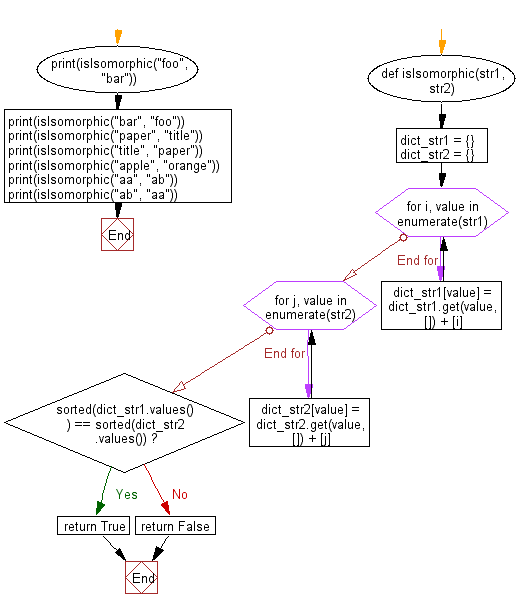Python: Check if two given strings are isomorphic to each other or not
Isomorphic Strings Check
In abstract algebra, a group isomorphism is a function between two groups that sets up a one-to-one correspondence between the elements of the groups in a way that respects the given group operations. If there exists an isomorphism between two groups, then the groups are called isomorphic.
Two strings are isomorphic if the characters in string A can be replaced to get string B
Given "foo", "bar", return false.
Given "paper", "title", return true.
Write a Python program to check if two given strings are isomorphic to each other or not.
Sample Solution:
Python Code:
# Function to check if two strings are isomorphic
def isIsomorphic(str1, str2):
dict_str1 = {} # Dictionary to store mapping for characters in str1
dict_str2 = {} # Dictionary to store mapping for characters in str2
# Enumerate through characters in str1 and store their positions in the dictionary
for i, value in enumerate(str1):
dict_str1[value] = dict_str1.get(value, []) + [i]
# Enumerate through characters in str2 and store their positions in the dictionary
for j, value in enumerate(str2):
dict_str2[value] = dict_str2.get(value, []) + [j]
# Check if the values (positions) in the dictionaries are the same after sorting
if sorted(dict_str1.values()) == sorted(dict_str2.values()):
return True
else:
return False
# Test cases
print(isIsomorphic("foo", "bar"))
print(isIsomorphic("bar", "foo"))
print(isIsomorphic("paper", "title"))
print(isIsomorphic("title", "paper"))
print(isIsomorphic("apple", "orange"))
print(isIsomorphic("aa", "ab"))
print(isIsomorphic("ab", "aa"))
Sample Output:
False False True True False False False
Explanation:
Here is a breakdown of the above Python code:
- Define a function named "isIsomorphic()" that takes two strings (str1 and str2) as input.
- Create two dictionaries (dict_str1 and dict_str2) to store the mapping of characters to their positions in each string.
- Use "enumerate" to iterate through characters in 'str1' and 'str2', and update the dictionaries accordingly.
- Check if the values (positions) in the dictionaries are the same after sorting.
- Return 'True' if the strings are isomorphic, and 'False' otherwise.
- Test the function with various input strings and print the results.
Visual Presentation:
Flowchart:

For more Practice: Solve these Related Problems:
- Write a Python program to check if two strings are isomorphic by establishing a one-to-one character mapping.
- Write a Python program to determine if two strings are isomorphic using dictionaries to track character correspondences.
- Write a Python program to validate the isomorphism of two strings by ensuring consistent and unique character mappings.
- Write a Python program to compare two strings and return whether they are isomorphic by verifying bidirectional mappings.
Go to:
Previous: Write a Python program to count the number of prime numbers less than a given non-negative number.
Next: Write a Python program to find the longest common prefix string amongst an given array of strings. Return false If there is no common prefix.
Python Code Editor:
Have another way to solve this solution? Contribute your code (and comments) through Disqus.
What is the difficulty level of this exercise?
Test your Programming skills with w3resource's quiz.
